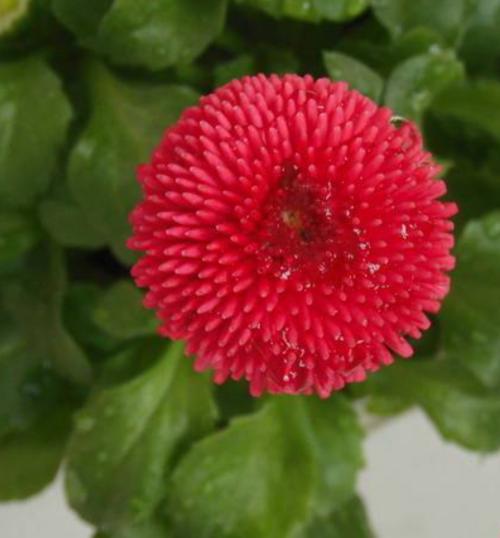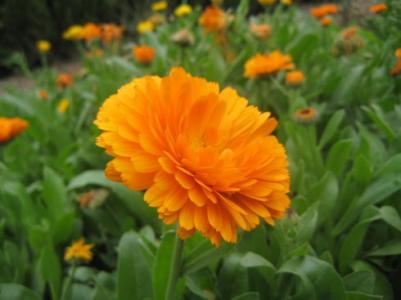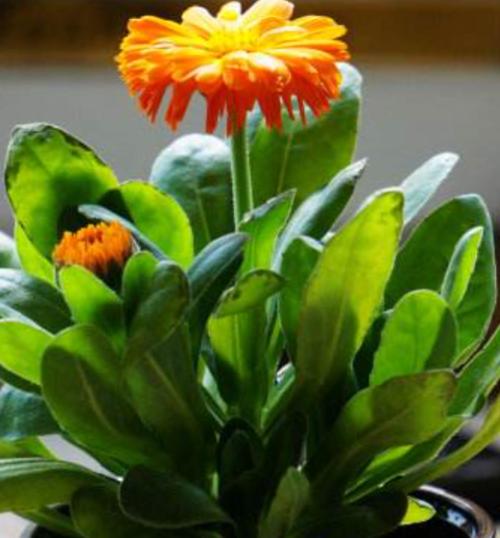Lawn Daisy (Bellis perennis) profile
Written by Maggie
Oct 28 2021

Lawn Daisy is a type of grass in the Compositae family. Lawn Daisy's about 10 centimeters high.
Lawn Daisy is native to Europe. The original species is treated as a bushy weed and blooms in the spring.
The lawn daisy can branch and reproduce on a cold area where she can get through the summer.
The Lawn Daisy flowers in early spring and is full of vitality. Lawn Daisy has a gentlemanly demeanor and naive demeanor. Lawn Daisy is very popular with the Italian people, so she was elected as the national flower.
Lawn daisy picture

Lawn daisy common Name(s):
Bairnwort
Banwood
Banwort
Benner Gowan
Bone Flower
Bonewort
Bruisewort
Common Gowan
Dog Daisy
Double Daisy
English Daisy
Goose Flower
Gowlan
Herb Margaret
Lawn Daisy
Lockin Gowan
Luckin Gowan
Marguerite
May Gowan
Noon Flower
True Daisy
Woundwort
Morphological characteristics of lawn daisy
Leaf
Lawn Daisy is a perennial or annual scape herb, about 10 cm high. Leaves are basal, grassy, spatulate, round tip blunt, base gradually narrow into a stalk, upper half of the edge of a sparsely obtuse teeth or undulate teeth.
Flowers
Inflorescences of Lawn Daisy are solitary, 2.5-3.5 cm in diam., scape hairy;Involucral bracts hemispherical or broadly bell-shaped; Involucral bracts are sub2-tiered, slightly unequal, oblong, apically obtuse, outside pilose. A layer of liguulate flowers, female, liguulate white to pinkish, spreading, entire or 2-3 dentate, central with many bisexual flowers, all fruited, tubular, eaves long, with 4-5 lobes.
Fruit
Achene of Lawn Daisy is oblate, laterally veined, veined or 1-veined on both sides. Corolla hairs are absent or connate with a synthetic ring and connate with corolla tube or achene.
The ecological habits of the lawn daisy
Lawn Daisy likes a cool climate and hates heat. Lawn Daisy is pleasant to light, and resistance to half shade, the cultivation of soil requirements are not strict. The suitable temperature for seed germination is 22-28°C and the suitable temperature for seed growth is 20-25°C. The southwest region is suitable for planting medium, floret single or semi-double varieties. Medium - and large-flowered varieties with double petals grew weakly and seeded poorly.
The growing methods of lawn daisy
Choose to soil preparation
Lawn Daisy are shallow-rooted plants. Raising seedling ground, should choose terrain flat, soil layer deep, loose and fertile and water source irrigation convenient places. The first year of autumn and winter over the land, in the spring of the next year before cutting propagation, and then combined with soil preparation and sufficient base fertilizer, shallow ploughing again. Then made into a wide 1.5 meters, long depending on the topography of the slotted bed, all around the good size of the drainage ditch, for the sake of drainage. For planting, it is advisable to choose the plot with high and dry terrain, sufficient sunshine, loose soil and good drainage, and sandy loam is the ideal.
Fertilization management
Lawn Daisy is a fertilizer crop, early nitrogen fertilizer should not be too much, reasonable increase in phosphate fertilizer, can make the chrysanthemum bud more, high yield. In addition to the application of basal fertilizer, in the growing period should also be top dressing 3 times: the first time after transplanting about half a month, when chrysanthemum seedlings began to grow alive, each mu of topdressing water 1000 kg of rare human and animal dung, or 8 kg ~ 10 kg of urea on the water pouring, to promote the growth of Lawn Daisy seedlings; The second time in the plant began to branch, each acre of water into a slightly thick 1500 kilograms of human and animal dung, or 50 kilograms of decoction cake fertilizer on water pouring, to promote more branches; The third before the pregnant bud, each acre of topdressing more concentrated human and animal dung water 2000 kilograms, or urea 10 kilograms plus calcium superphosphate 25 kilograms of water pouring, in order to promote more pregnant bud blossom.

How to care for lawn daisy
Lawn Daisy likes warm, cool climates and sunny, slightly dry environments. Lawn Daisy can withstand cold and be afraid of waterlogging. Lawn Daisy will not grow well in the shade. Growth period requires soil to be slightly moist, too dry, plants take out branches less, development is slow, yield is low, especially near flowering period, cannot be short of water, but moisture is too much, easy cause rot root dead seedling.
Lawn Daisy like fertilizer, in loose and fertile, rich humus, good drainage clips and soil growth is good, high yield flowers. The suitable soil is neutral to slightly acidic or slightly alkaline. It is not suitable for cultivation if the soil is sticky, low-lying, poorly drained and saline-alkali.
Avoid continuous cropping, successive years in the same land planting, pests and diseases, output and quality greatly decreased. Lawn Daisy is a short-day plant, which is sensitive to the length of sunlight and requires no more than 10 to 11 hours of light per day to bud and bloom.
Trimming care
In spring, remove wilted flowers regularly (deadheading) to stimulate the blooming.
This step aims at snipping all flower-bearing stems down from the crown head to stimulate lawn daisy growth while promoting the next flowering.
Watering care
During planting, water when the soil has dried to help the root system get set up.
After that, there’s no need to water except in case of prolonged dry spells or heat waves.
Note that water needs of lawn daisy when grown potted or in garden boxes are much higher, so you’ll have to water regularly.
Lawn Daisy's propagation
Division
(1) Before cultivating strong seedlings and selecting seedlings and picking flowers, select and retain strong and good lawn daisies with large flowers and make good marks. After the harvest of Lawn Daisy in autumn, the stems and branches are cut off to the ground, the root stump is dug up, and the plant is transplanted to a fertile plot, covered with decayed manure or soil manure to keep warm through the winter. In spring, when the height of Lawn Daisy seedlings is about 15 cm, root stump should be dug out, and the seedlings with strong and developed fibrous roots and no diseases and pests should be planted in the field immediately.
(2) Before planting, the roots were impregnated with 50% carbendazim 600 times solution for 12 hours to prevent leaf blight and other diseases. When planting, dig holes in the whole planting ground according to the row spacing of 40cm × 30cm, and plant 2 ~ 3 seedlings in each hole.
Cutting propagation
In spring or summer, in the Lawn Daisy top, choose to develop substantial, robust and insect-free stems for cuttings. Remove the young stem and cut it into small sections 10 to 15 centimeters long. At the lower end near the joint, cut it into a horse ear shaped inclined plane. First, soaked in water, quickly dipped in 1.5 ~ 3 g/kg indole acetic acid solution, took out to dry immediately after cutting. When inserting, on the whole good slotting machine, according to the line spacing of 10 cm ×8 cm to play the hole, the cuttings will be inserted into the hole oblique. The penetration depth of cuttings is 1/2 ~ 2/3 of ear length.About 20 days or so can be root. When the seedling height is about 20 centimeters, you can go out to plant. Planting density per acre with 4000 ~ 5000 plants is appropriate.
Lawn daisy's distribution area
Lawn Daisy originates from Europe, and cultivated in Chinese gardens as ornamental plants in flower beds.
The value of lawn daisy
Medicinal value
Lawn Daisy has very high medicinal value.It also has volatile oil, amino acids and a variety of trace elements. The brass content is 32 to 61 percent higher than other chrysanthemums, and the tin content is eight to 50 times higher.
Ornamental value
The Lawn Daisy leaves spatulate with a fascicular rosette, dense dwarf, green color. Take out flower scape from between leaves, scape a flower, strewn at random, appearance of primitive simplicity, flowers small and exquisite, color harmony. Take out flower scape from between leaves, scape a flower, strewn at random, appearance of primitive simplicity, flowers small and exquisite, color harmony.Blossom in early spring, full of vitality, with a gentleman's demeanor and naive style.
Horticultural value
Lawn Daisy growth potential is strong, easy to cultivate.
2. Lawn Daisy pedicel height moderate, neat flowers, bright and pure color, can be used as a pot plant to beautify the courtyard balcony, can also be used as garden ornamental, potted, flower, cut flowers, etc.
3. Lawn Daisy has a long flowering period, strong cold resistance, is the first choice of ground flowers in early spring.
4. Lawn Daisy as a street green ground flower, has a strong charm, and can be planted with calendula, pansy, azalea, berberry and other red leaves.

Read Next:
Top 10 Most Beautiful Roses in the World
Top 10 Most Beautiful Flowers in the World
26 Best Autumn Flowers to Plant for Fall Color in Garden
Latest Updated
- Benefits of Bugleweed - 7 Science-backed Health Benefits
- Bugleweed Dangers & Side Effects - Is It Poisonous?
- How to Plant Evergreen Trees - What You Should Know
- When to Plant Evergreens - Grow Guide for Evergreen Trees
- 12 Wonderful Evergreen Shrubs for Your Garden
- 12 Popular Evergreen Plants with Pictures for Beginners
- When And How To Prune A Lilac Bush Like a Pro
- How to Grow & Care for Lilac Vine (Hardenbergia Violacea)
- Japanese Lilac Tree (Syringa Reticulata) Care & Propagation Guide
- Shumard Oak Pros and Cons - What to Know
Popular Articles
- Winter maintenance of Antirrhinum Majus
- How to Grow Terminalia Mantaly Tree
- How to Grow and Care for Crossostephium Chinense
- How to grow Antirrhinum Majus in spring
- Peristeria Elata (Dove Orchid) Profile: Info & Care Guide
- Underwatered Snake Plant (Sansevieria Trifasciata) - Signs And How To Fix
- How to Care for Brazilian Jasmine Plant (Mandevilla Sanderi)
- How to Grow & Care for Graptopetalum Purple Delight in Summer
- Rosa Chinensis (China Rose): Plant Growing & Care Tips
- How to Care for Baby Sun Rose (Aptenia Cordifolia)